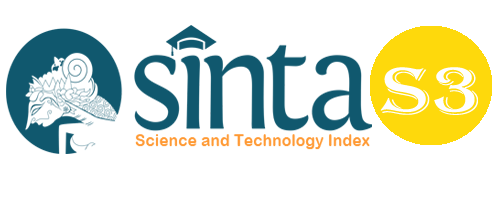Social Innovation in Poverty Reduction Through the Program for Construction of Unliable Housing in Central Java Province
Abstract
Paunescu (2014:106) states that social innovation can be used to approach social problems to bring about gradual change by a particular group of people or to overcome deep structural problems, which require change quickly and affect many people which have a scale of impact on, for example, unemployment or unemployment. poverty. This study aims to analyze and describe the implementation of social innovation in poverty alleviation through the Social Rehabilitation Program for Uninhabitable Houses in Central Java. By using qualitative research methods, and purposive techniques in determining informants. The results of the study indicate that social innovation through the improvement of uninhabitable houses for the poor carried out by the Central Java Provincial Government has not been optimal. Where the number of poor people in Central Java is still high (3,867.42 thousand people) with a percentage of 11.9% still above the national average, and uninhabitable houses that have not been handled are still 1,584,252 buildings. This is because there are still many internal and external parties who intervene on the authority of the leadership and data verifier officers in determining the community as recipients of the Social Rehabilitation program for Uninhabitable Houses in Central Java Province. And do not make the value of togetherness in building or repairing uninhabitable houses in the community, even though regulations, budgets, and other supporting infrastructure have been prepared by the Central Java Provincial Government to reduce poverty through the current housing improvement program.
Keywords
Full Text:
PDFReferences
Abdul Wahab, Solichin, (1997). Evaluasi Kebijakan Publik, Penerbit: FIA. UNIBRAW dan IKIP Malang.
Abdul Wahab, Solichin. (1990). Pengantar Analisis Kebijaksanaan Negara. Jakarta: Rineka Cipta
Abdul Wahab, Solichin. (2004). Analisis Kebijaksanaan: Dari Formulasi ke mplementasi Kebijaksanaan Negara, Jakarta: Bumi Aksara.
B. Miles, Matthew and Huberman, A. Michael, Saldana. (2014). Qualitative Data Analysis, Third Edition, Copyright SAGE Publications
Bridgman, Peter, and Glyn Davis. (2000). The Australian Policy Handbook Edition 2, Publisher: Allen & Unwin, 2000
Carl Patton, David Sawicki, Jennifer Clark. (2015). Basic Methods of Policy Analysis and Planning, Penerbit: Routledge.
Dye, Thomas R, (2005), Understanding Public Policy, Eleventh Edition, New Jersey: Pearson Prentice Hall.
Dye, Thomas R.(1981). Understanding Public Policy. Prentice-Hall.
Islamy, M Irfan. (2001). Prinsip-prinsip Perumusan Kebijaksanaan Negara. PT. Bina Aksara. Bandung.
Ismail, et al. (2019). The Community Perceptions of Poverty in Gampong Ayon, Seulimeum Sub-district, Aceh Besar Regency (Research Results on March 2017). Budapest International Research and Critics Institute-Journal (BIRCI-Journal). P. 270-275.
James E. Anderson, (1979).”Public Policy Making”, Holt, Rinchard & Winston, New York
James P. Lester dan Joseph Stewart (2000), Public Policy: An Evolutionary Approach, Australia: Wadsworth, second edition
Moulaert, F., MacCallum, D., Mehmood, A. and Hamdouch, A. (eds) (2014a) The International Handbook on Social Innovation: Collective Action, Social Learning and Transdisciplinary Research. Cheltenham: Edward Elgar
Mulgan, Geof et al. (2008). Transformers How local areas innovate to address changing social needs. Nesta: Making Inovation Flourish.
Nicholls, A. (2010) ‘The Institutionalization of Social Investment: The Interplay of Investment Logics and Investor Rationalities’, Journal of Social Entrepreneurship.
Nicholls, A. (2013) ‘The Social Entrepreneurship–Social Policy Nexus in Developing Countries’, in Walker, D. and Surrender, R. (eds), Social Policy in a Developing World: A Comparative Analysis. Oxford: Oxford University Press.
Nicholls, A. (ed.) (2006) Social Entrepreneurship: New Models of Sustainable Social Change. Oxford: Oxford University Press. Nicholls, A. (2010a) ‘The Legitimacy of Social Entrepreneurship: Reflexive Isomorphism in a Pre-Paradigmatic Field’, Entrepreneurship Theory and Practice.
Nicholls, A. and Cho, A. (2006) ‘Social Entrepreneurship: The Structuration of a Field’, in Nicholls, A. (ed.), Social Entrepreneurship: New Models of Sustainable Social Change. Oxford: Oxford University Press.
Nicholls, A. and Murdock, A. (eds) (2012) Social Innovation: Blurring Boundaries to Reconfigure Markets. Basingstoke: Palgrave Macmillan. Nicholls, A. and Opal, C. (2005) Fair Trade: Market-Driven Ethical Consumption. London: Sage.
Nigro, Felix A., Nigro, G.Lloyd, (1980), Modern Public Administration, Harper and Row, Publisher: New York.
Parson, Wayne (2005). Public Policy, Edward Elgar Publishing, Ltd. Jakarta: Prenada Media
Paunescu, Carmen. (2014). Social Inovation in Higher Education. Published by the registered company Springer Nature Switzerland AG.
Quade, E.S. (1984), Analisis for Public Decision, Penerbit: Nort Holland, New York
Wibawa, Samudra, dkk. 1994. Evaluasi Kebijakan Publik, PT. Raja Grafindo Persada, Jakarta.
DOI: https://doi.org/10.33258/birci.v5i2.4657
Article Metrics
Abstract view : 49 timesPDF - 29 times
Refbacks
- There are currently no refbacks.

This work is licensed under a Creative Commons Attribution-ShareAlike 4.0 International License.

This work is licensed under a Creative Commons Attribution-ShareAlike 4.0 International License.

_.gif)

















_.gif)



